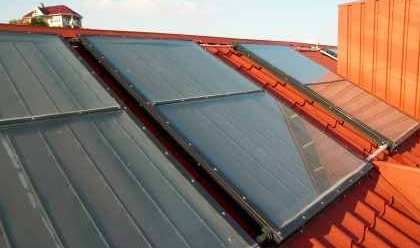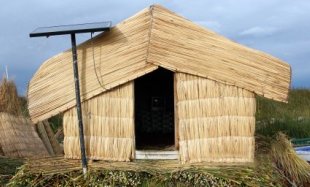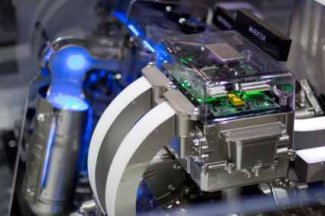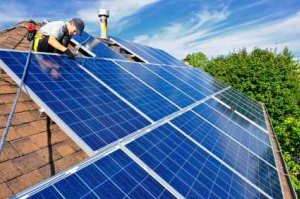- Home
- Home Energy
- Home Solar Power
Home Solar Power
Self-Sufficiency And Saving
Home solar power allows you to participate in establishing some of your own alternative energy production and being a part of the green revolution.
 Solar panels architecturally integrated into the roof design
Solar panels architecturally integrated into the roof designThere are a number of benefits.
Water Heating
Hot water heating is one of the biggest costs for energy use in the home, whether gas or electricity is used.
Whether you elect to heat the water directly with water-heating panels, or indirectly with electricity supplied from solar photovoltaic panels, you can reduce your monthly utility charges.
A recent exciting development for those wanting to adopt home solar power are hybrid panels that can generate electricity as well as heat water for direct use and for powering heating and cooling systems in the house. This hugely increases efficiency leading to a smaller panel footprint.
 Flat panels for solar water heating
Flat panels for solar water heatingNew Strategies
With the falling price of solar panels direct solar water heating panels are being used less and less. Strategies in home solar power for using excess generation to heat water before feeding it back to grid are also driving this. This usually saves you money as the price you receive for your power fed back to the grid in most places is less than what you have to pay for using the grid power.
Excess generated power can charge your battery storage as well before this is fed into the grid, again saving you multiple dollars. A well-designed control system is needed for this to direct the power in a cascade process.
New Zealand's innovative EnaSolar company arising from the earthquake ravaged Christchurch region has produced some well-priced scalable home solar power technology for this. Their ground-breaking, compact battery charging units have been taken up by Crown forklifts in the USA.
Adding to the impetus for the strategy above it is worth noting that roof top solar domestic water heating requires further duct penetrations through your membrane envelopes. This can result in additional costs and risks of extra energy losses if not well constructed.
 Off-grid solar power for Peruvian reed house
Off-grid solar power for Peruvian reed houseIndividual panels can be used to directly run an appliance or two especially in places with no direct electricity supply.
Changing Design Ideas
Photovoltaic panels can contribute to other energy uses about the home as well. Well designed they can appear as a complete part of the roof as in the picture at the top of the page.
New designs for home solar power are emerging that are less prominent than older solar panels. Thin panel technology is allowing for thin laminated continuous strips of panels that can be hid between the structure of the roofing profiles.
Also emerging are strategies that incorporate the photovoltaic elements as a thin effectively invisible layer on either your roofing material or within windows. Tata Steel in the UK is experimenting with the roofing ideas. Both Korean and US companies are working with the window approach. I have written more on this incorporated technology for those interested.
These latter two approaches could help those people in new housing areas where the developers will not allow the incorporation of solar panels into new builds until all the properties are sold. If the panels are not apparent they should be able to be used. Or you can pre-fit everything ready to go as in the EnaSolar idea.
Battery Storage
An important point to bear in mind with grid tie-in is that in the event of a grid power cut or outage, the power from the panels is not available, due to the system design! Unless you employ strategies like those above.
As mentioned above you can choose to have the panels charge deep cycle batteries which can then supply electricity at all times.
This option needs a diode or similar to stop the energy leaking back from battery to panels once the sun is no longer powering them.
It is expected that 2015 will see battery storage technology reach the point where it will be highly cost-effective for home owners to use this technology widely in their home solar power systems.
Inverters
And all panel power supplies for general house use will have an inverter to convert the generated DC current to a home AC one.

The company EnaSolar I mentioned above can pre-fit panels as you built or retrofit allowing you to insert your inverter and total control unit later. All the ducting and cabling required can be done at one time. You can then install the panels and inverter when you are ready. Multiple units can be added to scale up your power generation as you require.
Home solar panels can be arranged from a number of sources - big suppliers, smaller discounted ones to even local electronic shop supppliers.
Cost Of Home Solar Power
Generally the cost of a good usable array is not insignificant - it was in the region of $10,000 up until recently, but has fallen to the $2-3,000 range for a couple of kilowatts output. Therefore the time to pay back for the installation is rapidly falling. After this your account is in the positive.
Many countries and states are now offering incentives for home owners to adopt solar power for homes, which reduces the outlay significantly. Increasingly around the world there are companies effectively leasing the units to home owners at the cost you would normally pay for your power until they are paid back.

Your adoption of these alternative power sources reduces some of the government's future planning requirements.
Building Your Own Panels
For information on a great website that deals with creating your own solar panels well and at a great price check out the solar panel page at DIY Green Energy For Homes.
For those hobbyists out there it is possible to build your own solar panel arrays.
People have done it. And by sourcing the elements from various sources (with the web this gets so much easier), quite cheap but working units can be made.
If built from individual cells it is worth knowing that the units are very fragile. They need to be freighted and handled with great care. But you can build them to whatever voltage and current supply you need.
 Individual crystalline solar photovoltaic cell
Individual crystalline solar photovoltaic cellThey will need to be housed in something that protects them from moisture, direct damage and shock while still allowing light penetration to the cells. People have built their own very simple units for this.
Most areas will require proper electrical connection by a qualified electrician to connect with regular home energy supplies.
Likewise a plumber will be required to connect pipes from thermal solar heaters to your home hot water system.
If you plan to sell power back to the grid then consultation with your local electricity supplier will be required.

If you are lucky enough to be building a new home then some of these ideas can be incorporated at the outset. And designing it will allow for passive solar power benefits to reduce your energy needs.
This is covered in a further page on energy efficient design on the site to enable you to check your ideas and those that are emerging all the time.
Home solar power covers many options that allow you to benefit and create your own contribution to our planet and the future.
- Home
- Home Energy
- Home Solar Power
New! Comments
Have your say about what you just read! Leave me a comment in the box below.